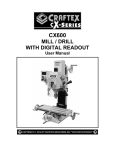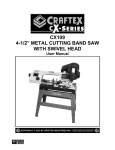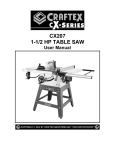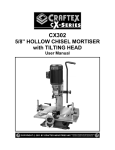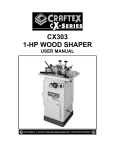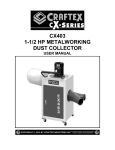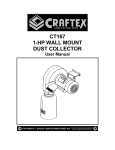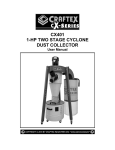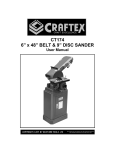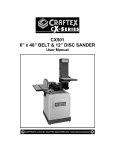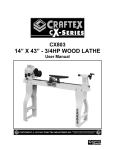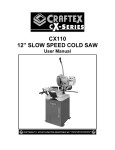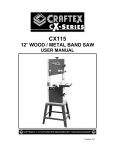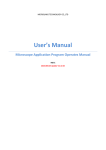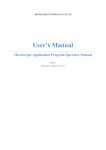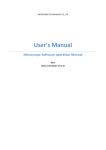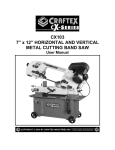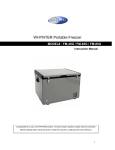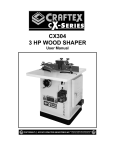Download CX603 - Busy Bee Tools
Transcript
CX603 1-1/2 HP KNEE MILLING MACHINE USER MANUAL V-1.0 TABLE OF CONTENTS General Safety Instructions for Machines ............................................................... 3 Specific Safety Instructions..................................................................................... 4 Features.................................................................................................................. 5 Physical Features ................................................................................................... 6 Proper Grounding ................................................................................................... 7 Un-Packing ............................................................................................................. 8 Setup ...................................................................................................................... 8 Cleaning.................................................................................................................. 8 Assembly ................................................................................................................ 9 Spindle Lubrication ................................................................................................. 10 ON/OFF Switch....................................................................................................... 10 Forward/Reverse Switch......................................................................................... 10 Test Run ................................................................................................................. 11 Table Controls.........................................................................................................11 Table Locks ............................................................................................................ 12 Table Limit Stops .................................................................................................... 12 Down Feed Controls ............................................................................................... 13 Head Tilting............................................................................................................. 13 Head Adaptor Rotation ........................................................................................... 14 Speed Change ........................................................................................................14 Maintenance ........................................................................................................... 15 Lubrication .............................................................................................................. 15 V-Belt Tensioning.................................................................................................... 17 Gibs Adjustment...................................................................................................... 17 Parts Diagram and Parts List .................................................................................. 18 Warranty ................................................................................................................. 26 2 GENERAL SAFETY INSTRUCTIONS FOR MACHINES Extreme caution should be used when operating all power tools. Know your power tool, be familiar with its operation, read through the owner’s manual, and practice safe usage procedures at all times. ALWAYS read and understand the user manual before operating the machine. CONNECT your machine ONLY to the matched and specific power source. ALWAYS wear safety glasses respirators, hearing protection and safety shoes, when operating your machine. NEVER leave a tool unattended while it is in operation. NEVER allow unsupervised or untrained person to operate the machine NEVER reach over the table when the tool is in operation. ALWAYS keep blades, knives and bits sharpened and properly aligned. DO NOT wears loose clothing or jewelry when operating your machine. Wear protective hair covering. ALL OPERATIONS MUST BE performed with the guards in place to ensure safety. A SAFE ENVIRONMENT is important. Keep the area free of dust, dirt and other debris in the immediate vicinity of your machine. ALWAYS use push sticks and feather boards to safely feed your work through the machine. BE ALERT! DO NOT use prescription or other drugs that may affect your ability or judgment to safely use your machine. DISCONNECT the power source when changing drill bits, hollow chisels, router bits, shaper heads, blades, knives or making other adjustments or repairs. ALWAYS make sure that any tools used for adjustments are removed before operating the machine. ALWAYS keep bystanders safely away while the machine is in operation. NEVER attempt to remove jammed cutoff pieces until the blade has come to a full stop. 3 CX603 – MILLING MACHINE SPECIFIC SAFETY INSTRUCTIONS READ AND UNDERSTAND the user manual before operating the milling/drilling machine. ALWAYS WEAR safety glasses for the protection of your eyes while operating this machine. WEAR PROPER APPAREL. Loose clothing, gloves neckties, rings, bracelets, or other jewelry may get caught in moving parts of the machine. Wear protective hair covering to contain long hair. Do not wear gloves and keep your fingers and hair away from rotating parts. KEEP GUARDS in place. Guards must be kept in place and in working order to ensure safe operation. MAKE SURE the work-piece is properly clamped to the table before operating the machine. Never hold the work-piece by hands when using the mill. MAKE SURE the cutting tool is sharp, not damaged and properly secured in the chuck before you start the machine. DO NOT turn the power ON with the cutting tool contacting the work-piece. SELECT THE PROPER SPINDLE SPEED for the type of work and material you are cutting. Let the spindle reach to its full speed before beginning a cut. DO NOT FORCE THE TOOL. Always use the machine at the rate for which it is designed. Do not force the machine doing a job for which it is not designed. NEVER LEAVE the machine unattended while it is running. ALWAYS turn off the power before removing scrap pieces and cleaning the machine. SHOULD ANY PART of your tool be missing, damaged or fail in any way, shut off the machine immediately and remove the plug from power source. Replace any damaged or missing parts before resuming operation. MAKE SURE before installing and removing any parts, servicing, cleaning or making any adjustments, the switch is in the “OFF” position and the cord is unplugged from the power source. BEFORE OPERATING your CX603 milling machine, make sure you have read and understood all the safety instructions in the manual and you are familiar with your machine. WARNING! The safety instructions given above can not be complete because the environment in every shop is different. Always consider safety first as it applies to your individual working conditions. 4 CX603 – MILLING MACHINE FEATURES MODEL CX603 – 1-1/2 HP KNEE MILLING MACHINE As part of the growing line of Craftex metalworking equipment, we are proud to offer the CX603, a 1-1/2HP Knee Milling Machine. By following the instructions and procedures laid out in this user manual, you will receive years of excellent service and satisfaction. The CX603 is a professional tool and like all power tools, proper care and safety procedures should be adhered to. Motor ................................... .......... 1-1/2 HP, 220 V, Single Phase Vertical Spindle Taper ......... .......... R8 or MT3 or NT30 Vertical Spindle Speeds ...... .......... 9 (230 - 2520 RPM) Spindle Travel...................... .......... 3-1/8" (80mm) Spindle to Column ............... .......... 7-1/2" Spindle to Table Surface ..... .......... 0" - 12-3/8" (0 - 345mm) Head Tilt .............................. ..........45° to the Right & 45° to the Left Table Surface ...................... .......... 8" x 30" Max. Table Cross Travel...... .......... 6" (150mm) Max. Table Longitudinal Travel....... 14-1/2" (370mm) Lead Screw.......................... .......... 1" x 8 TPI or 3mm Pitch Net Weight........................... .......... 450 Kg Gross Weight....................... .......... 540 Kg Warranty .............................. .......... 3 Years 5 CX603 – MILLING MACHINE PHYSICAL FEATURES Coarse Down Feed Handle V-Belt Cover V-Belt Tensioning Adjustment Bolt Fine Down Feed Hand Wheel 1-1/HP Motor Longitudinal Limit Stops Forward / Reverse Switch Longitudinal Locks Switch Box (ON & OFF) Table Height Crank Handle Longitudinal Hand Wheel Column Cross Feed Hand Wheel Cross Limit Stop Base Splash Pan Powder Coated Paint Knee 6 PROPER GROUNDING Grounding provides a path of least resistance for electric current to reduce the risk of electric shock. To prevent electrical hazards, have a qualified electrician ensure that the line is properly wired. This machine is for use on a normal 220 volts circuit. Make sure that the machine is connected to an outlet having the same configuration as the plug. If an adaptor plug is used, it must be attached to the metal screw of the receptacle. It is strongly recommended not to use extension cords with your CX603. Always try to position your machine close to the power source so that you do not need to use extension cords. If it necessary to use an extension cord, make sure the extension cord does not exceed 50-feet in length and the cord is 14gauge to prevent motor damage. Check for heat build up periodically. Your CX603 should be wired with a 3prongs plug fitting a 3 prong grounded receptacles as shown in figure-1. Do not remove the grounding prong to fit it into a 2pronged outlet. Always check with a qualified electrician if you are in doubt. Figure-1 220-Volts Outlet for CX603 WARNING! Improper connection of the equipmentgrounding conductor can result in a risk of electric shock. Check with a qualified electrician if you are in doubt as to whether the outlet is properly grounded. 7 UNPACKING The machine is properly packaged and shipped completely in crates for safe transportation. When unpacking, carefully inspect the crates and ensure that nothing has been damaged during transit. Open the crates and check that the machine and the parts are in good condition. NOTICE While doing inventory, if you can not find any part, check if the part has already been installed on the machine. Some parts come pre-assembled for shipping purposes. SETUP Before setting up your machine you should read and understand the instructions given in this manual. The machine comes mounted to the pallet and you need to unbolt it before moving the machine. Use a wrench and unbolt the milling machine from the pallet. Figure-2 Lifting the milling machine When setting up your machine, you will want to find an ideal spot where your milling machine will most likely be positioned most of the time. Consider your complete work environment before placing your machine in the ideal spot. CLEANING The unpainted surfaces of this table saw are coated with a rust preventive waxy oil and you will want to remove this before you begin assembly. Use a solvent cleaner that will not damage painted surfaces. Position the lifting straps around the machine and attach the other ends of the strap onto the forks of the fork truck. See figure-2. WARNING! CX603 is a very heavy machine, do not over-exert yourself. For safe moving method use fork truck. Failure to do so could result in serious personal injury and damage to the machine. 8 ASSEMBLY To assemble the CX603 milling machine, follow the instructions given below: Thread the handles into the longitudinal hand wheels located on both sides of the table. See figure-3. The crank handle comes assembled with its opposite side on the milling machine for shipping purposes. Remove the C-ring securing the crank handle to the machine and remove the crank handle. Re-install the crank handle to the milling machine as shown in figure-5 and secure it using the C-ring. Figure-3 Installing the longitudinal hand wheel handle on Thread the handle into table cross feed hand wheel located to the front side of the machine. See figure-4. Figure-5 Installing the crank handle Figure-4 Installing handle onto the cross feed hand wheel 9 SPINDLE LUBRICATION ON/OFF SWITCH The milling machine features metal to metal contacting parts and needs to be properly lubricated to ensure long life and performance. The switch box on CX603 is located on the right hand side of the machine featuring a green ON button and a red OFF button. To lubricate the spindle bearings: Lower the down feed handle all way to feed out the quill and rub the quill with a piece or rug having oil on it. See figure-6. Release the down feed handle and let the quill go to it is initial position. Locate the spindle lubrication cup on the mill shown in figure-6 and add a few drops of oil in it. Figure-7 Switch box FORWARD / REVERSE SWITCH CX403 features a forward / reverse switch which allows changing the rotating direction of the spindle. Figure-6 Lubrication the spindle WARNING! Lubricating the milling machine properly is an important task in order to maintain the machine at a high performance condition. Failure to follow reasonable lubrication practices could result premature failure of your machine. Figure-8 CX603 power cord 10 Once you have assembled your milling machine completely, it is then time for a test run to make sure that the machine works properly and is ready for operation. During the test run if there is any unusual noise coming from the machine or the machine vibrates excessively, stop the machine immediately and disconnect from the power source. Investigate to find out the problem with your machine. WARNING! 7. Now, push the red button and it should turn the machine OFF. TEST RUN Before starting the milling machine, make sure that you have read and understood the manual and you are familiar with the functions and safety features on this machine. Failure to do so may cause serious personal injury. TO TEST RUN THE CX603: 1. Make sure you have read the manual and understood all the safety instructions given in it. WARNING! Do not make any adjustments while the machine is running. Turn the machine OFF and un-plug the cord from the power source before making any adjustments. Failure to do so may cause serious personal injury. TABLE CONTROLS 2. Remove all the tools and objects from the machine, used during set up and assembly. The table on CX603 features three movement paths, controlled using crank handle and hand wheels. 3. Make sure the spindle is lubricated before turning the machine ON. See page-10 for details. See figure-9 for the three different paths in which the table can move. 4. Make sure the forward/reverse switch is in the OFF position and connect the power cord to the matched outlet and push the green button on the switch box. 5. Turn the forward/reverse switch to Forward position and verify that the machine is operating correctly. 6. Turn the forward/reverse switch to OFF position and then to Reverse position. See if the spindle rotates in the opposite direction. Figure-9 Three movement paths for the table 11 LONGITUDINAL HAND WHEELS Theses two hand wheels are located on the left and right sides of the table and allow to move the table to the right and to the left. CROSS FEED HAND WHEEL This hand wheel is located on the front side of the machine and is used to move the table towards or away from the column. CRANK HANDLE The crank handle is located on the front side of the machine, under the table and is used to raise or lower the table. Figure-12 Knee lock and saddle lock TABLE LIMIT STOPS Limit stops limit the travel distance of the table and saddle and allow repeatability while operation. Figure-10 Table movement controls TABLE LOCKS Figure-13 Longitudinal limit stops The table features lock levers to lock the table in position on each axis, preventing it from unwanted movement while operation. Figure-11 Longitudinal locks Figure-14 Cross limit stop 12 DOWN FEED CONTROLS This section give you information about the functions of the down feed controls. E. DOWN FEED STOP It stops the down feed assembly at the point where it is set. F. DOWN FEED SELECTOR KNOB Tightening this knob enables the fine down feed hand wheel while tightening it enables the coarse down feed handle. G. FINE DOWN FEED HAND WHEEL It raises and lowers the down feed assembly in small increment (when enabled). H. GRADUATED SCALE Figure-15 Down feed controls Shows quill travel in 0.001" increments when fine down feed hand wheel is used. HEAD TILTING The mill head on your CX603 tilts 90°left or right. To tilt the mill head: Figure-16 Down feed controls A. DOWN FEED HANDLE It is used to raise or lower the quill. Make sure the switch is in the OFF position the cord is disconnected from the power source. Loosen the four hex nuts securing the mill head to the head adaptor on both sides. See figure-17. B. QUILL LOCK It is used to lock the quill in position. C. DOWN FEED SCALE It shows the quill movement in inches. D. QUILL DOG It has a pointer on the side with the down feed scale and shows the depth of the down feed. Figure-17 Tilting the mill head 13 Tilt the head to the right or left and use the tilt scale to set the head at the correct angle. Re-tighten the four hex nuts properly, securing the mill head in position. SPEED CHANGE HEAD ADAPTOR ROTATION To change the spindle speed: The head adaptor rotates 360° around the column. To rotate the head adaptor: The CX603 is a 9-speed (230 - 2520 RPM) milling machine. The spindle speed can be changed as need for the material being cut. Make sure the switch is in the OFF position the cord is disconnected from the power source. Loosen the lock nut and then bolt shown in figure-19 to release tension on the belt. Make sure the switch is in the OFF position the cord is disconnected from the power source. Loosen the three hex nuts securing the head adaptor to the column. See figure-18. Figure-19 Releasing tension on the V-belt Figure-18 Rotating the head adaptor Arrange the belts, using the table in figure20 to get the correct RPM for your cutting operation and re-tension the V-belt and tighten the bolt and lock nut. Rotate the head adaptor with the head to the right or left and use the rotation scale to set the head adaptor to the correct angle. Re-tighten the three hex nuts properly, securing the head adaptor in position. Figure-20 Spindle RPM table 14 MAINTENANCE 5. Make sure your work area is well ventilated. During the life of your machine, you will need to practice some regular maintenance to keep your lathe in peak performance condition. 6. Good housekeeping practice should be followed on a daily basis keeping your lathe clean and well lubricated. 1. Treat your machine with care, keep it clean and grease and lubricate it regularly. Only through good care you can be sure that the working quality of the machine will remain constant. 2. Lubricate all slide ways lightly before every use. The change gears and the lead screw must also be lightly lubricated with lithium based grease. 3. During operation, the chips which fall onto the sliding surface should be cleaned in a timely fashion. Frequent inspections should be made to prevent chips from falling into the position between the work table and the slide ways. WARNING! Do not remove the chips with your bare hands. There is a risk of cut due to sharp-edged chips. Never use flammable solvents or cleaning agents or agents that generate noxious fumes. Protect electrical components such as motors, switches, switch boxes, etc..., against humidity when cleaning. 4. Every day, after the operation, eliminate all the chips and clean different parts of the machine tool and apply machine tool oil to prevent from rusting. 7. Check the machine everyday before operation for; worn or damaged cord, wire, loose nuts and bolts and make sure all the safety devices are working properly. LUBRICATION The milling machine features metal to metal contacting parts and needs to be properly lubricated to ensure long life and performance. WARNING! Lubricating the milling machine properly is an important task in order to maintain the machine at a high performance condition. Failure to follow reasonable lubrication practices could result premature failure of your machine. SPINDLE BEARINGS To lubricate the spindle bearings: Lower the down feed handle all way to feed out the quill and rub the quill with a piece or rug having oil on it. See figure-21. Release the down feed handle and let the quill go to it is initial position. 15 Locate the spindle lubrication cup on the mill shown in figure-6 and add 5-6 drops of oil in it. Practice this after every 8 hours of use. LEAD SCREWS & GEARS Use the crank handle and raise the table up to access the gears and lead screws underneath the table. Clean the gears and lead screws using a shop rag. Lubricate the gears and lead screws using #2 grease. See figures below. Figure-21 Spindle bearing lubrication ONE-SHOT OILER Open the fill cap on the one-shot oiler and pour ISO 68 lubricant (or equivalent) in it. The oiler features a sight glass which shows the amount of oil. Figure-23 Lubrication bevel gears and vertical lead screws Once the oiler is filled, pull the handle and release it so send lubricant. See figure-22. Figure-24 screws Figure-22 One-shot oiler Lubricate the machine using one shot oiler after every 8-9 hours of use (one pump only). Lubricating longitudinal lead Once you apply the lubricant on the gears and lead screws, move the table through the full range of each lead screw to distribute the lubricant. Lubricate the lead screws and gears in this manner after every 40 hours of use. 16 V-BELT TENSIONING Once the V-belt is tensioned properly, tighten the lock nut. The V-belt stretches with use and will need to be tensioned properly. To tension the V-belt: Make sure the switch is in the OFF position the cord is disconnected from the power source. Open the belt cover lock and lift the belt cover up to access the V-belt. GIBS ADJUSTMNET The table movements along the ways is controlled by gibs. Tight gibs increases table movement accuracy and but make it harder to move. Loose gibs make table movement sloppy but easier to move. Gibs should be adjusted so that the table does not move freely and at the same time it is not hard to move the table. To adjust the gibs: Disconnect the machine from the power source. Adjust the gibs using a screw driver and make sure not to tighten the gibs excessively, failure to do so could result premature wear of the sliding parts. Figure-25 V-belt Loosen the lock nut shown in figure-26 and rotate the bolt until the V-belt has approximately 1/8" of deflection when moderate pressure is applied. Figure-27 Adjustment gibs Figure-26 V-belt tension controls 17 18 19 20 21 22 23 24 25 WARRANTY CRAFTEX 3 YEARS LIMITED WARRANTY Craftex warrants every product to be free from defects in materials and agrees to correct such defects where applicable. This warranty covers three years for parts and 90 days for labor (unless specified otherwise), to the original purchaser from the date of purchase but does not apply to malfunctions arising directly or indirectly from misuse, abuse, improper installation or assembly, negligence, accidents, repairs or alterations or lack of maintenance. Proof of purchase is necessary. All warranty claims are subject to inspection of such products or part thereof and Craftex reserves the right to inspect any returned item before a refund or replacement may be issued. This warranty shall not apply to consumable products such as blades, bits, belts, cutters, chisels, punches etceteras. Craftex shall in no event be liable for injuries, accidental or otherwise, death to persons or damage to property or for incidental contingent, special, or consequential damages arising from the use of our products. RETURNS, REPAIRS AND REPLACEMENTS To return, repair, or replace a Craftex product, you must visit the appropriate Busy Bee Tools showroom or call 1800-461-BUSY. Craftex is a brand of equipment that is exclusive to Busy Bee Tools. For replacement parts directly from Busy Bee Tools, for this machine, please call 1-800-461-BUSY (2879), and have your credit card and part number handy. All returned merchandise will be subject to a minimum charge of 15% for re-stocking and handling with the following qualifications. Returns must be pre-authorized by us in writing. We do not accept collect shipments. Items returned for warranty purposes must be insured and shipped pre-paid to the nearest warehouse Returns must be accompanied with a copy of your original invoice as proof of purchase. Returns must be in an un-used condition and shipped in their original packaging a letter explaining your reason for the return. Incurred shipping and handling charges are not refundable. Busy Bee will repair or replace the item at our discretion and subject to our inspection. Repaired or replaced items will be returned to you pre-paid by our choice of carriers. Busy Bee reserves the right to refuse reimbursement or repairs or replacement if a third party without our prior authorization has carried out repairs to the item. Repairs made by Busy Bee are warranted for 30 days on parts and labour. Any unforeseen repair charges will be reported to you for acceptance prior to making the repairs. The Busy Bee Parts & Service Departments are fully equipped to do repairs on all products purchased from us with the exception of some products that require the return to their authorized repair depots. A Busy Bee representative will provide you with the necessary information to have this done. For faster service it is advisable to contact the nearest Busy Bee location for parts availability prior to bringing your product in for repairs. 26


























